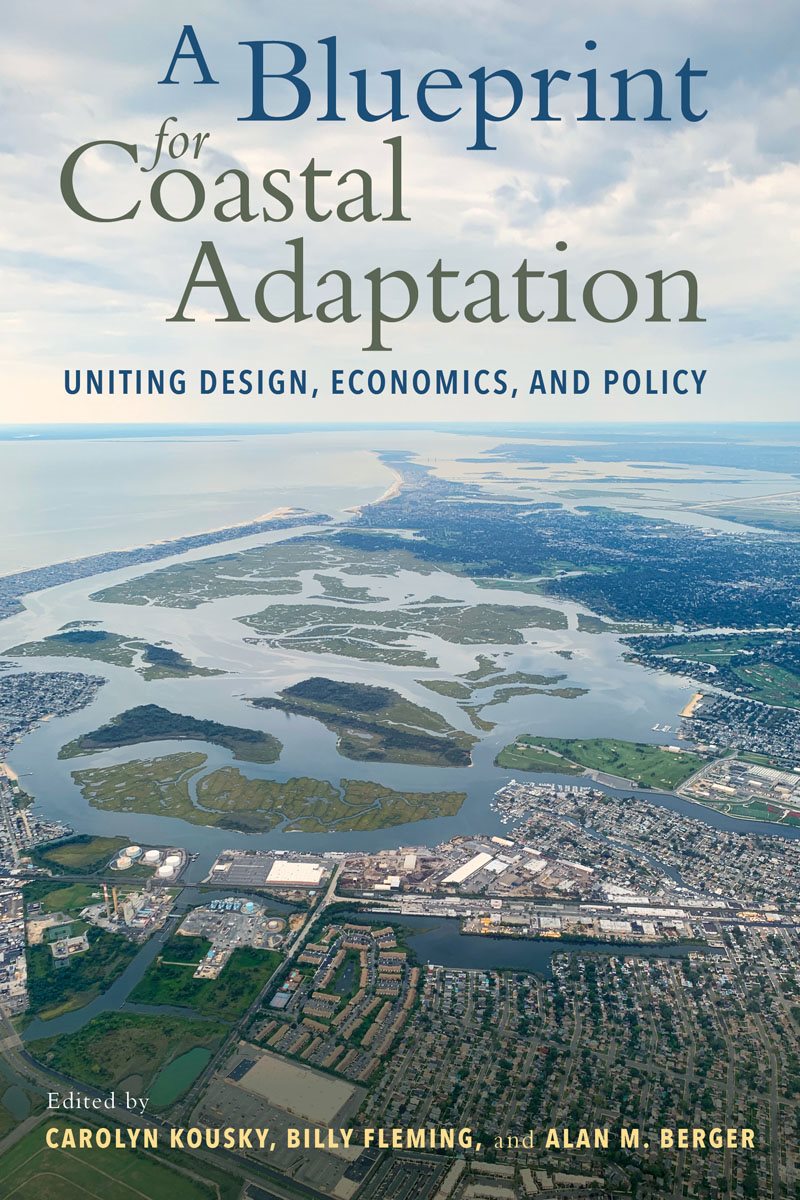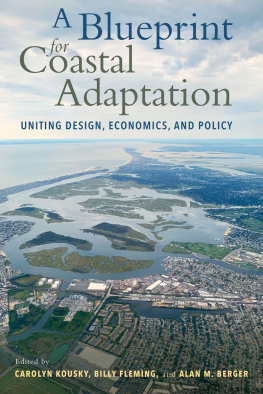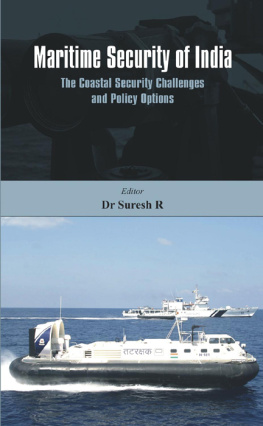Billy Fleming (editor) - A blueprint for coastal adaptation : uniting design, economics, and policy
Here you can read online Billy Fleming (editor) - A blueprint for coastal adaptation : uniting design, economics, and policy full text of the book (entire story) in english for free. Download pdf and epub, get meaning, cover and reviews about this ebook. year: 2021, genre: Romance novel. Description of the work, (preface) as well as reviews are available. Best literature library LitArk.com created for fans of good reading and offers a wide selection of genres:
Romance novel
Science fiction
Adventure
Detective
Science
History
Home and family
Prose
Art
Politics
Computer
Non-fiction
Religion
Business
Children
Humor
Choose a favorite category and find really read worthwhile books. Enjoy immersion in the world of imagination, feel the emotions of the characters or learn something new for yourself, make an fascinating discovery.
- Book:A blueprint for coastal adaptation : uniting design, economics, and policy
- Author:
- Genre:
- Year:2021
- Rating:5 / 5
- Favourites:Add to favourites
- Your mark:
- 100
- 1
- 2
- 3
- 4
- 5
A blueprint for coastal adaptation : uniting design, economics, and policy: summary, description and annotation
We offer to read an annotation, description, summary or preface (depends on what the author of the book "A blueprint for coastal adaptation : uniting design, economics, and policy" wrote himself). If you haven't found the necessary information about the book — write in the comments, we will try to find it.
A blueprint for coastal adaptation : uniting design, economics, and policy — read online for free the complete book (whole text) full work
Below is the text of the book, divided by pages. System saving the place of the last page read, allows you to conveniently read the book "A blueprint for coastal adaptation : uniting design, economics, and policy" online for free, without having to search again every time where you left off. Put a bookmark, and you can go to the page where you finished reading at any time.
Font size:
Interval:
Bookmark:

Since 1984, the nonprofit organization Island Press has been stimulating, shaping, and communicating ideas that are essential for solving environmental problems worldwide. With more than 1,000 titles in print and some 30 new releases each year, we are the nations leading publisher on environmental issues. We identify innovative thinkers and emerging trends in the environmental field. We work with world-renowned experts and authors to develop cross-disciplinary solutions to environmental challenges.
Island Press designs and executes educational campaigns, in conjunction with our authors, to communicate their critical messages in print, in person, and online using the latest technologies, innovative programs, and the media. Our goal is to reach targeted audiencesscientists, policy makers, environmental advocates, urban planners, the media, and concerned citizenswith information that can be used to create the framework for long-term ecological health and human well-being.
Island Press gratefully acknowledges major support from The Bobolink Foundation, Caldera Foundation, The Curtis and Edith Munson Foundation, The Forrest C. and Frances H. Lattner Foundation, The JPB Foundation, The Kresge Foundation, The Summit Charitable Foundation, Inc., and many other generous organizations and individuals.
Generous support for this publication was provided by Deborah Wiley.
The opinions expressed in this book are those of the author(s) and do not necessarily reflect the views of our supporters.

Island Presss mission is to provide the best ideas and information to those seeking to understand and protect the environment and create solutions to its complex problems. Click here to get our newsletter for the latest news on authors, events, and free book giveaways.

2021 Carolyn Kousky, William Fleming, and Alan M. Berger
All rights reserved under International and Pan-American Copyright Conventions. No part of this book may be reproduced in any form or by any means without permission in writing from the publisher: Island Press, 2000 M Street NW, Suite 480b, Washington, DC 20036
The editors gratefully acknowledge support for this project from the MIT Norman B. Leventhal Center for Advanced Urbanisim, the Ian L. McHarg Center for Urbanism and Ecology, and the Wharton Risk Management and Decision Processes Center of the University of Pennsylvania.
Carolyn Kousky thanks the National Science Foundation (award number 1939913) for support in the writing of of this volume.
Library of Congress Control Number: 2020944709
All Island Press books are printed on environmentally responsible materials.
Manufactured in the United States of America
10 9 8 7 6 5 4 3 2 1
Keywords: abandoned property, adaptation, community engagement, climate change, disaster financing, drinking water, dynamic shoreline, environmental impact bonds, equity, flood insurance, floodplain, flood risk reduction, insurance, land use, National Flood Insurance Program, natural hazards, mitigation strategies, public funding, Rebuild by Design, resilience, salt line, sea level rise, urban planning, water management, wetland protection, zoning
Jeff Goodell
I N LATE FEBRUARY 2019, I was part of a team of fifty scientists and crew members who sailed out of Punta Arenas, Chile, aboard the Nathaniel B. Palmer, a 308-foot-long icebreaker and scientific research vessel, bound for West Antarctica. We cruised through the Strait of Magellan, rolled for three days across the notoriously rough Drake Passage, and broke through many miles of sea ice. Then early on a Tuesday morning, on a remote section of the coast of the icy continent where few humans beings have ever ventured, the Doomsday Glacier loomed up out of the fog and revealed itself to us.
Peter Sheehan, twenty-seven-year-old researcher from the United Kingdoms University of East Anglia, was the first scientist aboard the Palmer to lay eyes on the enormous glacier. At around six oclock that morning, he climbed up five flights of stairs from the lab to the ships bridge, where he took sea ice assessments every hour throughout the night. And there it was: a big wall of ice on the starboard side of the ship, looming in the early morning light.
It was an eerie sightthe blue water, the blue sky, the blue ice, Sheehan told me later. It was all shades of blue.
Sheehan, who had never been to Antarctica before, was dumbstruck by the beauty of it all. He ran down to get his camera and then put on his coat and walked out to the bow of the ship, where he stood alone, one of the first human beings ever to confront this enormous glacier whose fate is inextricably linked with the future of coastal cities around the world. The scientifically correct name for the glacier is Thwaites, but at that moment, its informal nicknamethe Doomsday Glacierseemed much more fitting.
Usually I have a science mind, I am considering how were going to collect data, but at that moment, it was all the human reaction. I was just overwhelmed by the power and beauty of it.
Thwaites Glacier is one of the most important tipping points in Earths climate system. One way to think of Thwaites, which is about the size of the state of Florida, is as the cork in the wine bottle for the entire West Antarctic Ice Sheet. If it collapses, it could eventually dump enough ice into the ocean to cause seas to rise by ten feet or more. That would doom Miami, Boston, New York City, London, Shanghai, Jakarta, and virtually every other coastal city in the world. As Thwaites goes, so go coastal cities as we know them.
If that sounds melodramatic, well, we live in melodramatic times. As I wrote in The Water Will Come, my recent book about the causes and consequences of sea level rise: The simple truth is the climate is warming, the worlds great ice sheets are melting, and the water is rising. This is not a speculative idea, or the hypothesis of a few wacky scientists, or a hoax perpetuated by the Chinese. Sea-level rise is one of the central facts of our time, as real as gravity. It will reshape our world in ways most of us can only dimly imagine.

By 8:00 a.m., virtually the entire science and support team on the Palmermaybe twenty-five peoplecrowded up onto the bridge, which is like a skybox five levels above the main deck, with big windows and a bridgewalk that lets you stroll around outside. We all had our cameras and iPhones out, snapping pictures as we cruised along the hundred-foot-tall craggy face of Thwaitess ice shelf. The weather was oddly warm and welcomingthe wind calm, the sea tranquil. The Palmer was able to get within a few hundred feet of the calving frontan extremely rare thing to be able to do at any glacier, much less a giant like Thwaites, due to the risk of falling ice.
I talked with Rob Larter, the chief scientist on the trip. Its more chaotic than I expected, he said when I asked him about his first impressions of the glacier. He explained that most ice shelves in Antarctica are flatthey are like slices of wedding cake. In contrast, many sections of the Thwaites ice shelf were a jumbled mess, with big crevasses and sloping shoulders. To Larter, the sloping shoulders of the ice shelf meant there was a lot of melting going on at the base of the ice sheet, which meant there was probably a lot of warm Circumpolar Deep Water flowing in below. Later, research done aboard the
Next pageFont size:
Interval:
Bookmark:
Similar books «A blueprint for coastal adaptation : uniting design, economics, and policy»
Look at similar books to A blueprint for coastal adaptation : uniting design, economics, and policy. We have selected literature similar in name and meaning in the hope of providing readers with more options to find new, interesting, not yet read works.
Discussion, reviews of the book A blueprint for coastal adaptation : uniting design, economics, and policy and just readers' own opinions. Leave your comments, write what you think about the work, its meaning or the main characters. Specify what exactly you liked and what you didn't like, and why you think so.













